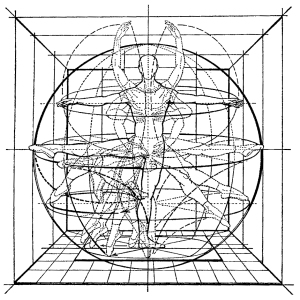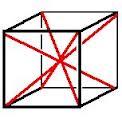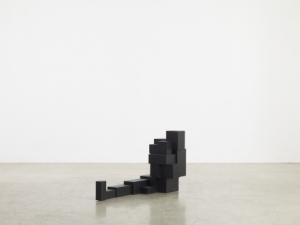The notion of kinesphere was created by Rudolf Laban to define: “the sphere around the body whose periphery can be reached by easily extended limbs without stepping away from that place which is the point of support when standing on one foot” (1966, p.10). This spherical space around our body shifts as soon as we shift our weight. It is also the first area of movement exploration before going into “space in general”. It follows anatomical limitations, being actually more elliptic than spherical as constitutionally, the average body has a wider area of reach forward than backward.
Visibly speaking the kinesphere stays invisible until the moment we move within it and make it tangible by leaving our trace-forms, the spatial consequences of our movements (Preston-Dunlop, 1981, p.27).
Taking the body as a reference (called “body cross”, although Laban considered we can also look at space using other references), the kinesphere is also the container of a cube (containing all diagonal directions and dimensions) and of an icosahedron made by three bi-dimensional planes: it contains angular geometry inside a round geometry.
This very precise geometry is also the supporting structure for our personal interactions, defining personal space and body territory.
Antony Gormley in his last exhibition Model at The White Cube, created a series of works that articulate the relationship between these two different types of geometry and questions the way we inhabit our personal space.
In this project that “investigates our experience of architecture through the body and of the body through architecture”[1], instead of molding his sculptures on his body, Gormley has chosen parallelepiped iron blocks as a geometrical unit for the construction of buildings of all sizes that present human-like features[2], putting in relation the idea of pixel used in computer technology and the physical body. [3]
One of the rooms contains a giant body construction open to visitors: through their physical interaction with it, they explore this dark interior whose structure recalls traditional architecture.
I visited it. Before entering, one must agree not to climb on or in it. Deprived from far sight my first instinct is to measure the limits of the space I am in to visualize its structure, and my first area of reach is my kinesphere. I move it horizontally mostly and a little bit up and down , but with the limitation of not changing altitude I have to extend myself on the architecture hoping to reach its limits. After having crawled, stretched onto the cold floor and walls, and jumped endlessly to reach one room’s ceiling unsuccessfully, I left with the experience that this body we inhabit all the time still contains unknown dimensions.
The notion of kinesphere has been expanded in the dance practice, particularly in two strands of movement research:
- Experimenting with the notion of centre:
William Forsythe has expanded the kinesphere: area of maximum easy reach, to “super-zone” and “mini-zone”: areas of off-balance reach and areas of minimum reach. In his choreographic material, he mostly plays between these two extremes, to which he has added the notion of decentralization: movement can take place around a centre either in the body (that doesn’t need to exist anatomically), or outside of the body: a virtual centre. Moving through his perception of space, Forsythe creates not one but many kinespheres that change size, multiply, fragment, collapse and disappear swiftly (Baudoin&Gilpin, 2004).
- 360 degree exploration and shared kinesphere:
For Steve Paxton, “Contact Improvisation is a study of physics […], Newton’s paradigms, [in which] we are Newton’s apples themselves” (Franklin, 1996, p.57). Paxton plays with the “kinesphere-apple” that he considers 360 degree, any body part being potentially able to sustain the body weight in motion, in relation to other “apples” of the same kind. Following a rolling point of contact between two bodies, the kinesphere becomes a shared space around a common moving centre and sometimes around a unique gravity centre.[4]
All of the research around spatial considerations of the kinesphere make the subsequent human relationships more ambiguous in terms of theatricality, dancers becoming at the same time more animal and more technological for an outside eye, like alienated.
In D’avant by Ballets C. de la B., we can see how the performers have physically pushed the notion of interdependence to the absurd, choosing costumes that allow them to create a comic meaning for an audience.
[1] exhibition description
[2] the sculptures were inspired by some of Peter Brook’s characters
[3] interview, exhibition video
[4] for a comparative view of duets you may want to watch a minute of each of these: http://www.youtube.com/watch?v=45nvgqkUJTY (Forsythe&Caspersen)
http://www.youtube.com/watch?v=k768K_OTePM (Paxton&Stark-Smith)







